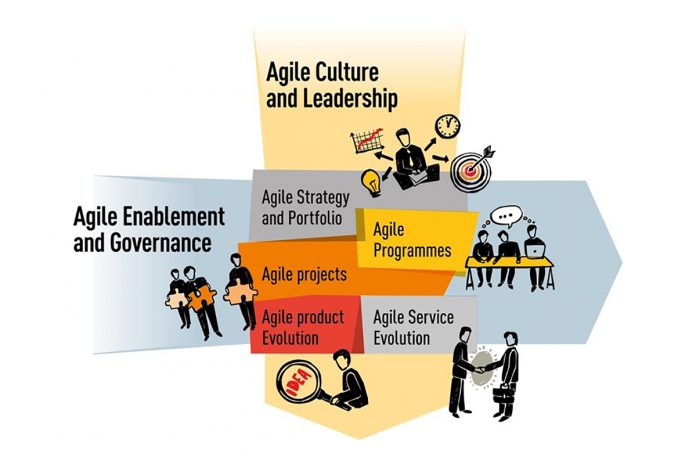Agile transformation is enabling change and adding value across the public and private sectors, as Agile Business Consortium Member Hugh Ivory outlines
The term “Agile” is often misunderstood and consequently, there are many interpretations of what it is. Although Agile has its roots in software delivery, it has now grown well beyond this to be much more. It is more than a set of methods, practices and behaviours. Agile is about delivering value for an organisation, however that value might be defined. In government, for example, that value could be defined as meeting citizens’ needs; in the private sector, meeting customers’ needs; in healthcare, meeting patients’ needs.
So for clarity, when I use the term, I mean “an approach where people with a variety of appropriate knowledge and skills collaborate to deliver value in the most effective way (early and often)”.
In this context, Agile is an enabler for transforming organisations, departments and teams; highly relevant and effective for the public sector as it strives to deliver ever more value in a fast-changing world.
Agile transformation requires new approaches across a number of dimensions:
- Delivery (engineering) – where the push for Agile normally starts, from practitioners influenced by education, social media, peers, pragmatism
- Governance (management) – once the delivery teams start doing things differently, ways of governing and assuring are challenged to remain fit for purpose
- Organisation (culture) – the changes being driven from the delivery and governance dimensions will highlight issues with an organisation’s culture which need to be understood and addressed
Those of you in delivery teams using Agile to build products and services will often feel frustrated, hamstrung by the mechanisms and structures that delay your progress. You should realise that the leaders in your organisation want the same thing as you – the delivery of value, early and often. They want to protect their investment, and they look for assurance that it is possible. You can help by explaining how iterative and incremental delivery, with the frequent demonstration of how the end result will look, protects their investment. Providing easy access to your information and reports, and inviting them to visit you will often help.
Delivering the Agile transformation
Those of you in leadership positions want your organisations to be Agile and adaptive, to react to the forces of change – reduced budgets, new legislation and better-informed customer and citizen needs. You may be frustrated by the pace and cost of change. You will be concerned about the risk of wasted investment and the consequences of that in terms of investor, regulator and media scrutiny. Because of this, you look for assurance and the appropriate governance to safeguard your investment.
If you have good Agile delivery teams, their very approach is safeguarding your investment. They will ask you to empower your best, most visionary people to work with them to deliver what you really need. They will ask for time to explore, make mistakes and learn. They will ask for your patience – don’t expect the false certainty of a two-year plan – let them know your desired outcome, give them space to figure it out. Visit them as often as you can – they’ll welcome you.
Those of you responsible for governing and assuring are caught in the middle of this drive for agility and adaptability. You are expected to be the brokers between the sponsors and the delivery teams, facilitating the means for ensuring that money is invested appropriately and is being used effectively.
You will need to create the conditions whereby leaders can:
- Make decisions about the most important things to do
- Allocate skilled, knowledgeable and empowered people to the delivery teams
- Come and see the progress for themselves; delivery teams will expect that the information they generate as they work should be sufficient to demonstrate progress and control
- Everyone will also expect you to ensure that governance approaches add value and don’t slow down delivery.
In a nutshell, the potential for Agile to enable organisational transformation can only be fully realised when all of you (leaders, managers and delivery teams) align your behaviour as you mature from focusing on the delivery dimension, (using Agile practices to deliver a specific product or service) through to the organisational dimension (harnessing agility to create an adaptive, learning and evolving organisation).
Enabling Agile business
The Agile Business Consortium is a not-for-profit membership organisation that promotes, supports and enables Agile Business by providing advice and guidance through an accredited range of Agile frameworks, products and services.
The Agile Business Consortium is coordinating the work of experienced Agile practitioners across a broad spectrum of disciplines and sectors to create the Agile Business Change Framework launching this year. To find out more about this, and how you can get involved, visit www.agilebusiness.org.
Hugh Ivory is a Member of the Agile Business Consortium and the COO at Agilesphere LLP. Agilesphere is working with the Agile Business Consortium to develop and promote Agile business change initiatives.
Hugh Ivory
Member
COO
Please note: this is a commercial profile











